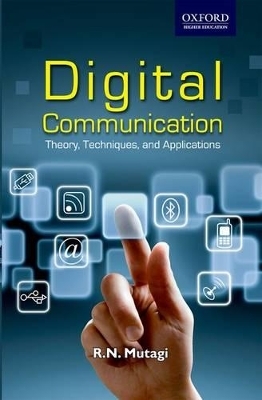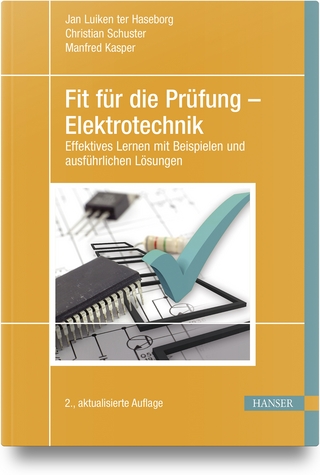
Digital Communication
Oxford University Press (Verlag)
978-0-19-807549-3 (ISBN)
- Titel ist leider vergriffen;
keine Neuauflage - Artikel merken
Digital Communications: Theory, Techniques and Applications is written for students of both undergraduate and post-graduate degree programs in engineering for a course on digital communication. In the first four chapters the book builds the theoretical background necessary to understand the principal ideas of digital communication systems. Thereafter, the book in chapters 5 through 9 discusses the core concepts such as digital coding, multiplexing and multiple access, digital modulation, demodulation and detection. The last chapter of the book discusses the applications of digital communication in the domains of satellite, optical and wireless communication systems. Heavily illustrated with more than 500 figures to help understand and relate to theoretical concepts better, the book also provides graded solved problems, challenging review questions, and numerical exercises for the practice.
R. N. Mutagi is currently Professor and Head, Department of Electronics and Communication Engineering at the Industrial Institute of Technology and Engineering, Ahmedabad. He is a Senior Member of IEEE (Communication Society and Signal Processing Society), Fellow of Broadcast Engineering Society (BES) and Fellow of the Institute of Electronics and Telecommunication Engineers (IETE). He has four decades of experience in R&D in space industry, technology development, systems engineering, technical management, project and people management and teaching in India and Canada. As the Head of Baseband Processing Division at ISRO he has developed satellite communication systems for the major satellite communication programs of ISRO including SITE, STEP, AUP and, GSAT.
1: Introduction; 1.1 introduction; 1.2 Typical Digital Communication System; 1.3 Advantages of Digital Communication; 1.3.1 Regeneration of digital signals; 1.3.2 Power efficiency of digital modulators; 1.3.3 Bandwidth compression; 1.3.4 Multimedia: unification of signals; 1.3.5 Performance; 1.3.6 Technology; 2: Communication Signals and Systems; 2.1 Introduction; 2.2 Time and Frequency Representation; 2.2.1 Fourier Series; 2.2.2 Fourier Transform; 2.2.3
Discrete-Time Fourier Transform; 2.2.4 Discrete Fourier Transform; 2.3 Convolution; 2.4 Corelation; 2.5 Hilbert Transform; 2.6 Bandpass and Lowpass Representations; 2.6.1 Bandpass Signals and Systems; 2.6.2
Analytic Signal; 2.6.3 Lowpass Equivalent Signals; 2.7 Signal Space Representations; 2.7.1 Vector Space; 2.7.2 Signal Space; 2.7.3 Orthonormal Representation of Signals; 2.7.4 Gram-Schmidt Procedure; Summary; Review Questions; Problems; 3: Probability and Random Processes; 3.1 Introduction; 3.2 Probability; 3.2.1 Set Theory; 3.2.2 Probability space; 3.2.3 Properties of probability; 3.2.4 Probability of joint events; 3.2.5 Conditional probability; 3.2.6 Bayes' Rule; 3.2.7 Independence; 3.3
Random Variables; 3.3.1 Probability Distribution Function; 3.3.2 Probability Density Function; 3.3.3 Probability Mass Function; 3.3.4 Mean and Variance; 3.3.5 Some common distributions; 3.3.6 Functions of
Random Variables; 3.3.7 Multiple Random Variables; 3.3.8 Central Limit theorem; 3.4 Random Processes; 3.4.1 Properties of Random Processes; 3.4.2 Some examples of Random Processes; Summary; Review Questions; Problems; 4: Information Theory; 4.1 Introduction; 4.2 Information Measure; 4.2.1 Self-Information; 4.2.2 Entropy; 4.2.3 Discrete Memoryless Source (DMS); 4.2.4 Joint and Conditional Entropy; 4.2.5 Mutual Information; 4.3 Discrete Channel; 4.3.1 Statistics of the Discrete Channel; 4.3.2
Channel Capacity; 4.4 Continuous Random Variable; 4.4.1 Differential Entrop; 4.4.2 Capacity of Continuous Channel; 4.5 Source Coding; 4.5.1 Source Efficiency and Redundancy; 4.5.2 Kraft inequality; 4.5.3
Source coding theorem; 4.5.4 Shannon-Fano Encoding; 4.5.5 Huffman Coding; 4.5.6 Non-binary Huffman coding; Summary; Review Questions; Problems; 5: Digital Coding; 5.1 Introduction; 5.2 Digitizing Analog Signals; 5.2.1 Sampling; 5.2.2 Quantization; 5.2.3 Encoding; 5.3 Signal Compression; 5.3.1 Signal Statistics and Redundancy; 5.3.2 Companded PCM; 5.3.3 Predictive Coding; 5.3.4 Transform Coding; 5.3.5 Parametric Coders; 5.3.6 Perceptual coding; 5.4 Application of Digital Coding; 5.4.1 Digital
Speech; 5.4.2 Digital Audio; 5.4.3 Digital Video; Summary; Review Questions; Problems; 6: Multiplexing and Multiple Access; 6.1 Introduction; 6.2 Multiplexing; 6.2.1 Frequency Division Multiplexing;
6.2.2 Concept of Time Division Multiplexing; 6.2.3 Frame Synchronization; 6.2.4 Primary Multiplexing in Digital Telephony; 6.2.5 Higher Order Multiplexing; 6.3 Multiple Access; 6.3.1 Frequency Division Multiple Access (FDMA); 6.3.2 Time Division Multiple Access (TDMA); 6.3.3 Code Division Multiple Access (CDMA); 6.3.4 Random Access 6-23; 6.3.5 Carrier Sense Multiple Access-Collision Detection (CSMA-CD); 6.3.6 Fixed Assignment and Demand Assignment Multiple Access; Summary; Review Questions;
Problems; 7: Digital Modulation; 7.1 Introduction; 7.2 Baseband Modulation; 7.2.1 Pulse Amplitude Modulation; 7.2.2 Baseband Signaling; 7.2.3 Correlative Coding; 7.3 Bandpass Modulation; 7.3.1 Bandpass
PAM; 7.3.2 Quadrature Amplitude Modulation (QAM); 7.3.3 Digital Phase Modulation (Phase Shift Keying); 7.3.4 Digital Frequency Modulation (Frequency Shift Keying); 7.3.5 Minimum Shift Keying (MSK); 7.4 Power Spectral Density; 7.4.1 Power Spectral Density of Baseband Signals; 7.4.2 Power spectral Density of Bandpass Signals; 7.5 Comparison of Basic Modulations; 7.6 Some Special Modulation Techniques; 7.6.1 OFDM; 7.6.2 Spread Spectrum Modulation; 7.6.3 Trellis Coded Modulation; Summary; Review
Questions; Problems; 8: Demodulation and Detection; 8.1 Introduction; 8.2 Optimum Receiver; 8.2.1 Correlation Demodulator; 8.2.2 Matched Filter; 8.2.3 Matched Filter Demodulator; 8.3 Binary Detection;
8.3.1 Probability of error; 8.3.2 Decision Rules; 8.3.3 Sufficient Statistics; 8.3.4 Performance of an optimal receiver; 8.4 General Binary Detection; 8.4.1 Implementation of a general binary receiver; 8.4.2 Performance of a general binary receiver; 8.4.3 Signals with equal energy; 8.4.4 Detection of Bandpass Signals; 8.5 M-ARY Detection; 8.5.1 4-PAM signal; 8.5.2 Gray Coding; 8.5.3 QPSK signals; 8.5.4 M-ary PAM signals; 8.5.5 Performance Bounds; 8.6 Non Coherent Detection; 8.6.1 Non-coherent
detection of binary signals; 8.6.2 Error Performance of Non-coherent Receiver; 8.6.3 Differential PSK; 8.7 Equalization; 8.7.1 Linear Transversal Filter Equalizer; 8.7.2 Non-linear Equalizers; Summary;
Review Questions; Problems; 9: Error Control Coding; 9.1 Introduction; 9.1.1 Types and Measures of Error; 9.1.2 Shannon-Hartley Capacity Theorem; 9.1.3 Concepts behind Error Detection and Correction -A bigger picture; 9.1.4 Methods of Error Control; 9.1.5 Classification of Error Correcting Codes; 9.2 Linear Block Codes; 9.2.1 Hamming Distance; 9.2.2 Hamming Weight; 9.2.3 Error Detection and Correction Capabilities of a Code; 9.2.4 Codeword Error Probability Computation; 9.2.5 Generator Matrix;
9.2.6 Systematic Codes; 9.2.7 Parity Check Matrix; 9.2.8 Syndrome; 9.2.9 Standard Array; 9.2.10 Implementing the Decoder 9-21; 9.3 Cyclic Codes; 9.3.1 Generator Polynomial for Cyclic Code; 9.3.2
Systematic Cyclic Code; 9.3.3 Polynomial Multiplication and Division; 9.4 Important Block Codes; 9.4.1 Hamming Codes; 9.4.2 BCH Codes; 9.4.3 Golay Codes; 9.4.4 Reed-Solomon Codes; 9.5 Convolutional Codes; 9.5.1 Convolutional Encoder; 9.6 Convolutional Decoding; 9.6.1 Maximum Likelihood Decoding and Viterbi Algorithm; 9.6.2 Sequential Decoding and Fano Algorithm; 9.7 Turbo codes; 9.7.1 Turbo coding; 9.7.2 Turbo decoding; 9.8 Low Density Parity Check codes; 9.8.1 Graphical representation of LDPC
Codes; 9.8.2 Decoding of LDPC codes; 9.9 Practical Applications of Error Correcting Codes; 9.9.1 Deep Space Communication; 9.9.2 Satellite Communication; 9.9.3 Data Transmission; 9.9.4 Data Storage;
9.9.5 DAB/DVB; 9.9.6 Mobile and Wireless Systems; Summary; Review Questions; Problems; 10: Applications of Digital Communication; 10.1 Introduction; 10.2 Cellular Communication; 10.2.1 Cellular Concept; 10.2.2 Cellular Standards; 10.3 Digital Satellite Communications; 10.3.1 Elements of a Satellite Communication System; 10.3.2 Link analysis; 10.3.3 Multiple Access; 10.3.4 Special Techniques in Satellite Communication; 10.3.5 Digital Satellite systems; 10.4 Optical Communication; 10.4.1
Advantages of Optical Communication; 10.4.2 Signal Transmission in an Optical Fiber; 10.4.3 Optical Transmission Systems; 10.4.4 Optical Telecommunication Networks; 10.4.5 Applications of Optical Fibers; 10.5
Wireless Network Access; 10.5.1 Wi-Fi; 10.5.2 WiMAX; 10.5.3 ISDN; Summary; Review Questions; Problems; Appendix A - Trigonometric Functions; Appendix B - Table of Q Functions
| Erscheint lt. Verlag | 20.12.2011 |
|---|---|
| Zusatzinfo | 350 diagrams |
| Verlagsort | Oxford |
| Sprache | englisch |
| Gewicht | 864 g |
| Themenwelt | Technik ► Elektrotechnik / Energietechnik |
| Technik ► Nachrichtentechnik | |
| ISBN-10 | 0-19-807549-9 / 0198075499 |
| ISBN-13 | 978-0-19-807549-3 / 9780198075493 |
| Zustand | Neuware |
| Haben Sie eine Frage zum Produkt? |
aus dem Bereich


